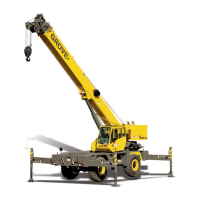Manitowoc Published 07-19-16, Control # 249-01 5-31
2250 SERVICE/MAINTENANCE MANUAL HOISTS
INSPECTING SHEAVES, ROLLERS, AND
DRUMS
Perform the following inspections weekly.
1. Check the drum clutches and brakes for proper
adjustment.
2. Check all sheaves, rollers, and drums for the following
conditions:
- Unusual noises
- Freedom of movement—Sheaves, rollers, and
drums must turn freely by hand. The wire rope may
need to be loosened to perform this inspection.
- Wobble—Sheaves, rollers, and drums must turn
true with very little side-to-side or up-and-down play.
- Signs of rust (indicating that water may have
entered the bearing)
- Grease leaks (indicating a faulty seal or water in the
grease)
The above problems indicate bearing damage. If found,
the corresponding sheave, roller, or drum should be
disassembled for further inspection. New bearings
should be installed.
For sheaves not equipped with grease fittings, make
sure to pack new bearings with grease at assembly.
3. For steel sheaves, check the depth, width, and contour
of each sheave using a groove gauge (Figure 5-29
).
Replace sheaves that have over- or undersized
grooves.
4. Replace grooved drums that allow one wrap of wire rope
to contact the next wrap as the rope spools onto the
drum.
5. Inspect the sheaves to verify they do not contact another
sheave or structural plate work. There should be uniform
clearance between sheaves in a cluster. Repair or
replace worn or damaged sheaves.
FIGURE 5-29
A925
135° to 150°
Observe the groove to see if the contour of the gauge
matches the contour at the bottom of the sheave groove.
A proper fitting sheave groove should support wire
rope at 135° to 150° of the rope’s circumference.
Groove Too Small
Groove Too Large
Wrong
Right
